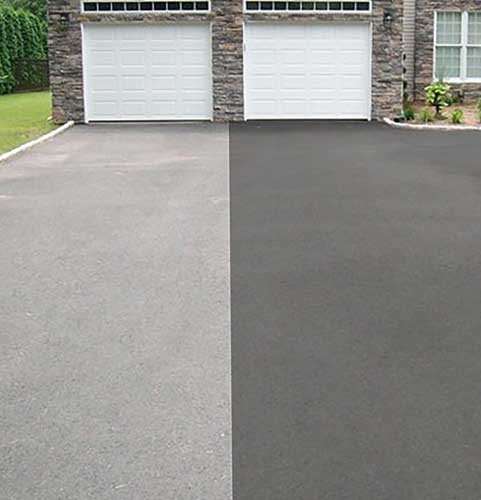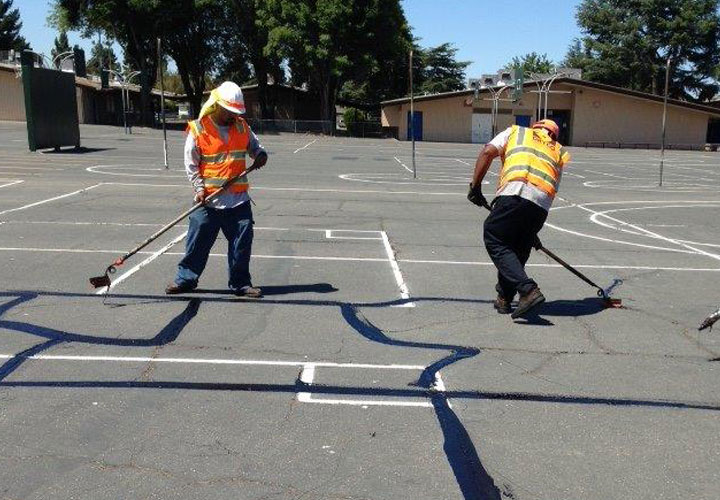Swift Solutions for Asphalt Spot Repair: Ideal Sealing Strategies
Swift Solutions for Asphalt Spot Repair: Ideal Sealing Strategies
Blog Article
Cold Mix Asphalt Vs. Hot Mix Asphalt: Which Is Right for You?

Structure Differences
Cold mix and hot mix asphalts vary considerably in their make-up, with unique features that affect their performance and applications. Cold mix asphalt is produced by emulsifying the asphalt binder with water and an emulsifying agent prior to blending it with accumulation. This method enables the asphalt to be practical at reduced temperature levels, making it suitable for momentary fixings and for use in chillier climate problems. Warm mix asphalt, on the other hand, is manufactured at high temperatures, commonly in between 300-350 ° F, which aids to attain far better compaction and a more long lasting final item. The warm mix asphalt production process involves heating up the aggregate and asphalt binder separately prior to combining them at the asphalt plant.
Additionally, chilly mix asphalt often tends to be less dense and extra flexible than warm mix asphalt. This adaptability makes it much better suited for locations with higher levels of activity, such as driveways or roads with hefty web traffic. On the other hand, warm mix asphalt is known for its high longevity and resistance to rutting and cracking, making it a favored choice for highways and high-traffic roads where durability is essential.
Installment Process Variations
The procedure of setting up cool mix and warm mix asphalt displays significant variations in their demands and procedures. Cold mix asphalt, being a much more flexible product, can be applied straight from the bag or container onto the pothole or damaged area. It calls for marginal preparation job, such as cleaning the location and compacting the cold mix with hand tools. This makes it a convenient alternative for fast and short-lived fixes. In contrast, hot mix asphalt necessitates an extra elaborate installation process. It entails heating up the blend to heats before laying it down on a correctly prepared base. The preparation includes compacting the base, using a tack coat, and using hefty equipment like pavers and compactors for a smooth and durable surface. As a result of the heating requirements, hot mix asphalt installments are generally lugged out by specialists with specific tools, making sure a more irreversible and structurally sound result.
Sturdiness and Long Life Elements
When considering asphalt options, durability and durability are important aspects to assess for lasting pavement efficiency,. Hot mix asphalt (HMA) is understood for its extraordinary resilience and durability. The high temperatures throughout the mixing and laying process allow for far better compaction, leading to a denser and more powerful pavement framework. This leads to HMA being a lot more immune to rush hour tons, harsh weather, and the effects old contrasted to chilly mix asphalt (CMA)
In terms of longevity, HMA typically exceeds CMA because of its remarkable toughness and resistance buildings. HMA pavements have a longer life span, requiring much less frequent repair services and upkeep, which can translate to set you back financial savings in the long run. Furthermore, HMA pavements are more easily personalized to satisfy certain project demands, additionally enhancing their longevity.
Expense Considerations
Considering the financial effects is a crucial aspect when examining the selection in between warm mix asphalt (HMA) and chilly mix asphalt (CMA) for sidewalk projects. While the first expense of warm mix asphalt is typically greater than that of cool mix asphalt, HMA commonly gives a much more cost-efficient remedy in the future because of its superior toughness and longevity. HMA is understood for its capacity to stand up to rush hour lots and harsh climate condition, minimizing the demand for regular repairs and upkeep. On the other hand, cool mix asphalt is extra budget friendly upfront but might need even more frequent patching and resurfacing, causing higher upkeep prices over time.
Along with material costs, it's important to take into consideration the expenditures linked with installation and maintenance when contrasting HMA and CMA. HMA normally requires specialized devices and competent labor for proper installment, which can affect general job costs. On the other hand, CMA is less complicated to work with and can often be used making here use of easier strategies, possibly reducing installation expenditures. Ultimately, the decision between HMA and CMA ought to consider not simply the initial cost yet also the lasting financial implications to figure out one of the most affordable choice for the certain sidewalk project.
Environmental Impact Comparison
Contrast of the environmental impacts between warm mix asphalt (HMA) and cold mix asphalt (CMA) exposes unique distinctions in sustainability practices. HMA production requires heats, causing boosted power intake and greenhouse gas emissions. The process likewise releases volatile organic compounds (VOCs) and dangerous air contaminants (HAPs) into the ambience. In contrast, CMA is generated and used at lower temperature levels, decreasing power usage and emissions dramatically. The lower manufacturing temperature levels of CMA cause reduced gas consumption and lower levels of carbon dioxide exhausts, making it an extra eco pleasant alternative.
Additionally, the use of CMA typically involves anchor recycling existing asphalt pavement, advertising resource preservation and minimizing the quantity of waste sent to garbage dumps. By deciding for CMA over HMA, roadway building and construction jobs can contribute positively to ecological preservation initiatives.
Verdict
In conclusion, the option between chilly mix asphalt (CMA) and hot mix asphalt (HMA) depends on different elements such as structure, installation process, sturdiness, longevity, cost, and environmental effect. angle parking. While CMA supplies a fast and cost-efficient solution for minor repair work, HMA makes certain exceptional toughness and durability for go to this web-site rush hour locations. Consider these variables very carefully to identify which kind of asphalt is the appropriate selection for your paving requires

Taking into consideration the monetary effects is an important element when examining the selection in between hot mix asphalt (HMA) and cold mix asphalt (CMA) for sidewalk projects. While the preliminary price of warm mix asphalt is normally greater than that of cold mix asphalt, HMA frequently offers a much more economical option in the long run due to its superior toughness and long life. asphalt repair.Comparison of the ecological influences in between warm mix asphalt (HMA) and cold mix asphalt (CMA) discloses unique differences in sustainability practices.In final thought, the option between cool mix asphalt (CMA) and hot mix asphalt (HMA) depends on various elements such as make-up, setup process, durability, durability, price, and ecological effect
Report this page